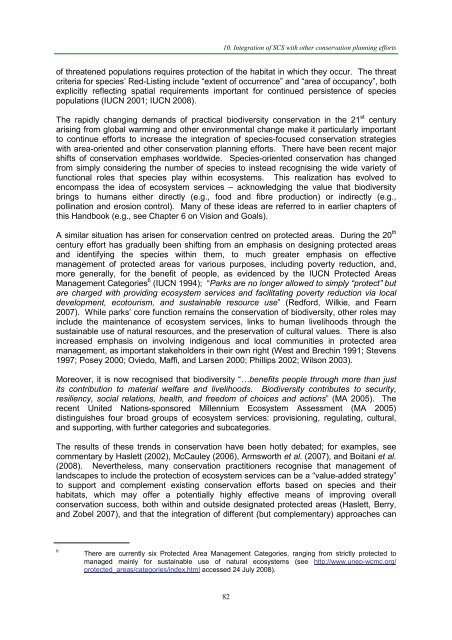Strategic Planning for Species Conservation: A Handbook - IUCN
Strategic Planning for Species Conservation: A Handbook - IUCN
Strategic Planning for Species Conservation: A Handbook - IUCN
Create successful ePaper yourself
Turn your PDF publications into a flip-book with our unique Google optimized e-Paper software.
10. Integration of SCS with other conservation planning ef<strong>for</strong>ts<br />
of threatened populations requires protection of the habitat in which they occur. The threat<br />
criteria <strong>for</strong> species’ Red-Listing include “extent of occurrence” and “area of occupancy”, both<br />
explicitly reflecting spatial requirements important <strong>for</strong> continued persistence of species<br />
populations (<strong>IUCN</strong> 2001; <strong>IUCN</strong> 2008).<br />
The rapidly changing demands of practical biodiversity conservation in the 21 st century<br />
arising from global warming and other environmental change make it particularly important<br />
to continue ef<strong>for</strong>ts to increase the integration of species-focused conservation strategies<br />
with area-oriented and other conservation planning ef<strong>for</strong>ts. There have been recent major<br />
shifts of conservation emphases worldwide. <strong>Species</strong>-oriented conservation has changed<br />
from simply considering the number of species to instead recognising the wide variety of<br />
functional roles that species play within ecosystems. This realization has evolved to<br />
encompass the idea of ecosystem services – acknowledging the value that biodiversity<br />
brings to humans either directly (e.g., food and fibre production) or indirectly (e.g.,<br />
pollination and erosion control). Many of these ideas are referred to in earlier chapters of<br />
this <strong>Handbook</strong> (e.g., see Chapter 6 on Vision and Goals).<br />
A similar situation has arisen <strong>for</strong> conservation centred on protected areas. During the 20 th<br />
century ef<strong>for</strong>t has gradually been shifting from an emphasis on designing protected areas<br />
and identifying the species within them, to much greater emphasis on effective<br />
management of protected areas <strong>for</strong> various purposes, including poverty reduction, and,<br />
more generally, <strong>for</strong> the benefit of people, as evidenced by the <strong>IUCN</strong> Protected Areas<br />
Management Categories 6 (<strong>IUCN</strong> 1994); “Parks are no longer allowed to simply “protect” but<br />
are charged with providing ecosystem services and facilitating poverty reduction via local<br />
development, ecotourism, and sustainable resource use” (Red<strong>for</strong>d, Wilkie, and Fearn<br />
2007). While parks’ core function remains the conservation of biodiversity, other roles may<br />
include the maintenance of ecosystem services, links to human livelihoods through the<br />
sustainable use of natural resources, and the preservation of cultural values. There is also<br />
increased emphasis on involving indigenous and local communities in protected area<br />
management, as important stakeholders in their own right (West and Brechin 1991; Stevens<br />
1997; Posey 2000; Oviedo, Maffi, and Larsen 2000; Phillips 2002; Wilson 2003).<br />
Moreover, it is now recognised that biodiversity “�benefits people through more than just<br />
its contribution to material welfare and livelihoods. Biodiversity contributes to security,<br />
resiliency, social relations, health, and freedom of choices and actions” (MA 2005). The<br />
recent United Nations-sponsored Millennium Ecosystem Assessment (MA 2005)<br />
distinguishes four broad groups of ecosystem services: provisioning, regulating, cultural,<br />
and supporting, with further categories and subcategories.<br />
The results of these trends in conservation have been hotly debated; <strong>for</strong> examples, see<br />
commentary by Haslett (2002), McCauley (2006), Armsworth et al. (2007), and Boitani et al.<br />
(2008). Nevertheless, many conservation practitioners recognise that management of<br />
landscapes to include the protection of ecosystem services can be a “value-added strategy”<br />
to support and complement existing conservation ef<strong>for</strong>ts based on species and their<br />
habitats, which may offer a potentially highly effective means of improving overall<br />
conservation success, both within and outside designated protected areas (Haslett, Berry,<br />
and Zobel 2007), and that the integration of different (but complementary) approaches can<br />
6 There are currently six Protected Area Management Categories, ranging from strictly protected to<br />
managed mainly <strong>for</strong> sustainable use of natural ecosystems (see http://www.unep-wcmc.org/<br />
protected_areas/categories/index.html accessed 24 July 2008).<br />
82

















